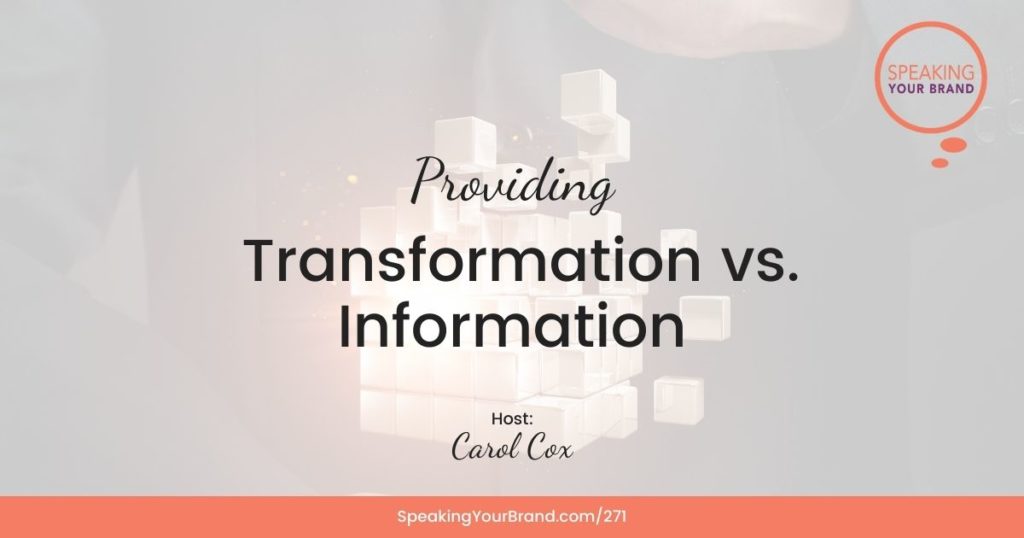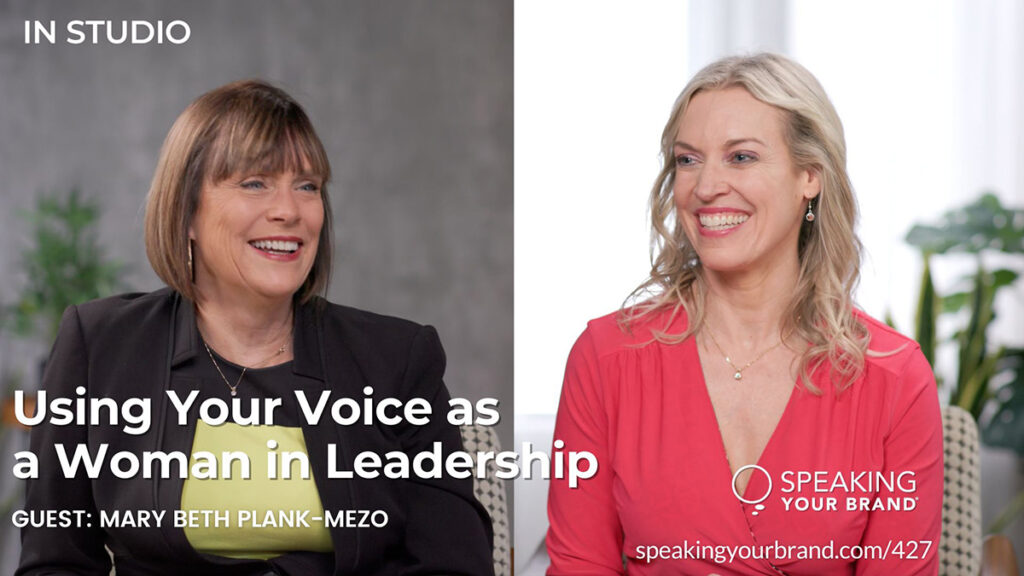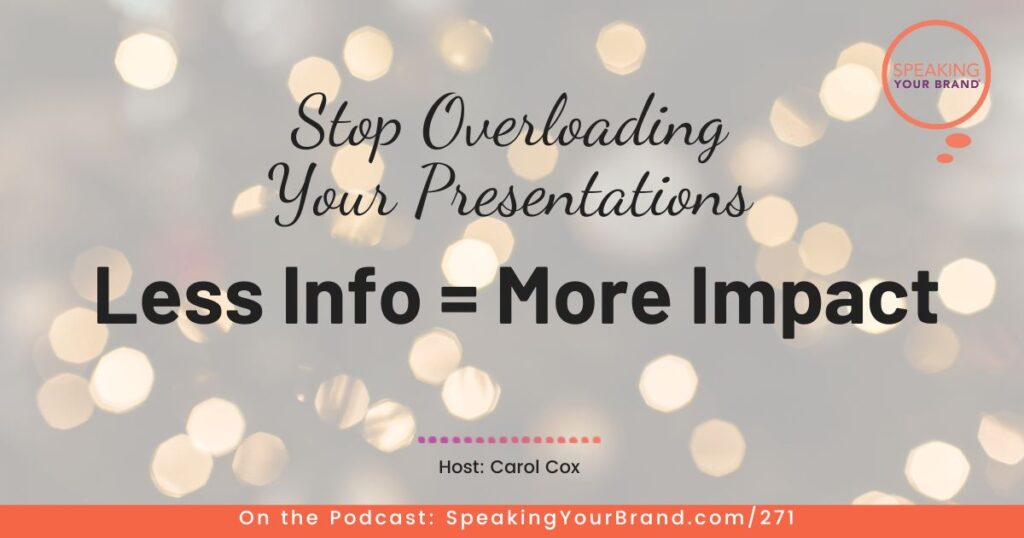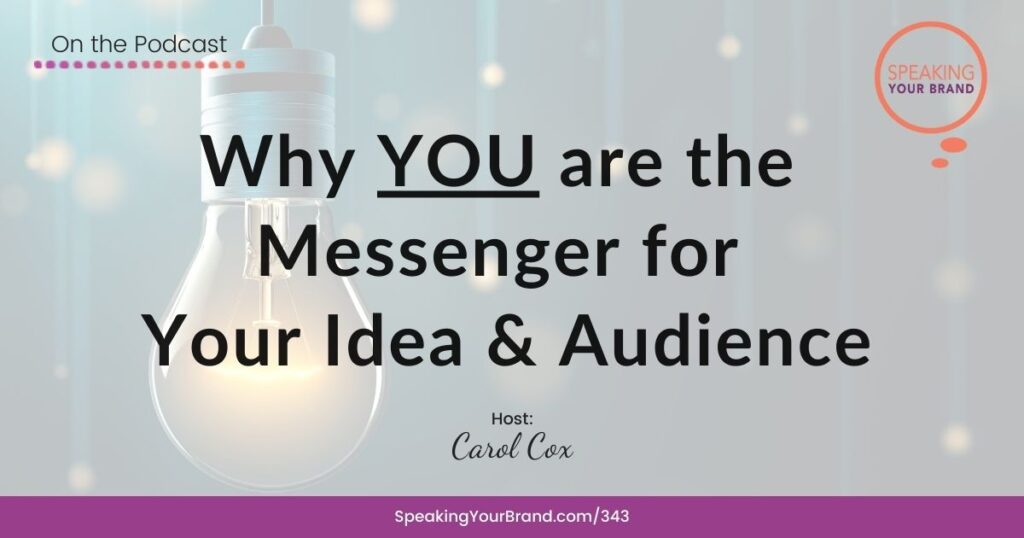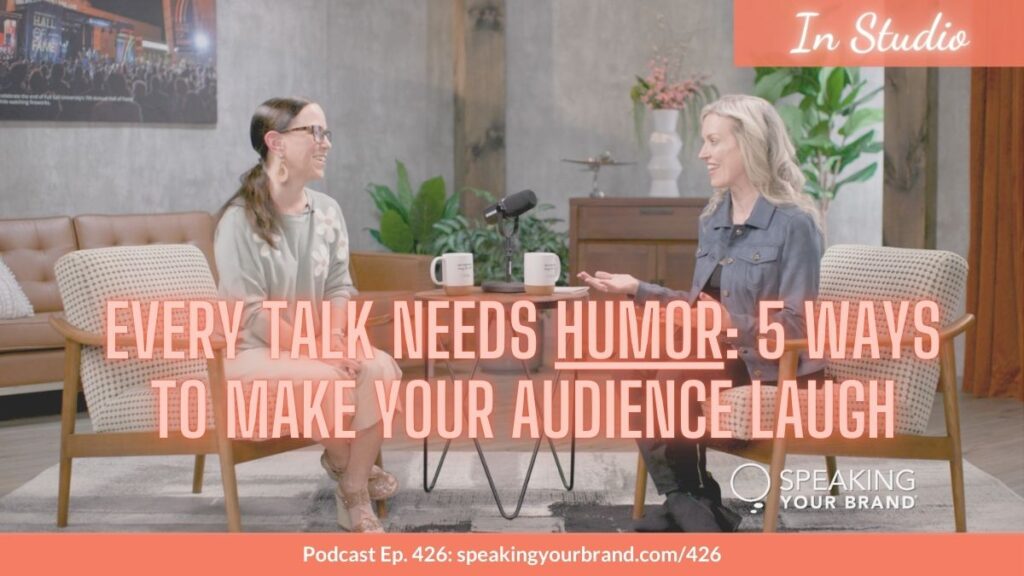271-SYB-Transformation-vs-Information.mp3: this mp3 audio file was automatically transcribed by Sonix with the best speech-to-text algorithms. This transcript may contain errors.
Carol Cox:
Are you providing transformation or information in your presentations in content here while you want to increase the transformation and decrease the information in this episode of The Speaking Your Brand podcast. More and more women are making an impact by starting businesses running for office and speaking up for what matters. With my background as a TV political analyst, entrepreneur and speaker, I interview and coach purpose driven women to shape their brands, grow their companies, and become recognized as influencers in their field. This is Speaking Your Brand, your place to learn how to persuasively communicate your message to your audience. Hi there and welcome to the Speaking Your Brand podcast. I’m your host, Carol Cox. The past few episodes have showcased some of our recent graduates from our Thought Leader Academy. Last week we had on Christie Rocca, and Christie and I talked about the hub and spokes of your thought leadership message. The week before that was with Nicole Edwards, and we talked about creating a memorable bit for a keynote talk. That’s a really fun one. And then the week before that, we had Kelly Carlstrom, who’s a pharmacist and our lead speaking coach, Diane Diaz, and they talked about working together to create Kelly’s lead generation signature talk. So those are great episodes to listen to. If you want to get a sense of what the women in our Thought Leader Academy work on and how they’re using their thought leadership and their signature talks. Today, I want to talk about providing information versus transformation in your presentations, your keynotes and your content in general.
Carol Cox:
So there’s a difference between information and transformation. I know that whenever I work on a presentation like a training or even a keynote or the agenda for the in-person client retreat we’re holding in April, my default, my instinct is to think, first of all, the information I want to convey to the audience, everything I want to teach, all the tips, all the techniques, all the strategies. And you may be the same way, but I want to challenge you like I challenge myself to reduce the information and increase the transformation. And I know this may at first seem counterintuitive because of course we want to provide value to our audiences, but I promise you there is more value in transformation than there is an information. And why is this? Because you’ll have a bigger impact on your audience when they can see what’s possible for themselves, and also by providing more transformation than information. This is the way you get traction on your thought leadership message, and this is how you can increase your prices both for the speaking fees that you charge and the pricing for the services and programs that you offer. So we’re going to dive into that today. I shared on LinkedIn recently that I’m a bit obsessed with business TV shows like Succession We Crash and Inventing Anna. I’ll share later in this episode the three lessons I’ve taken from watching these real and fictional characters.
Carol Cox:
Three positive lessons that we can take. Because certainly if you’ve watched any of these shows, you know that what they do, what these main characters do is not always what we would want to role models. So we’re going to take three positive lessons from that. Now let’s get on with the show. I don’t know about you, but I feel inundated with information all of the time, whether it’s updates from the people I follow on social media podcasts, I listen to shows, I watch the news articles that I read. It’s just a lot of information to consume day in and day out. And of course, I enjoy it. I enjoy the podcast, I listen to the TV shows that I watch the LinkedIn post from people I follow and so on. But it’s still a lot, and this is why I want you to start thinking about transformation and not so much information in your presentations and content. In times past, information was harder to get. You had to go to the library to look up something. You remember doing that back in the day? I certainly do. You had to buy a set of encyclopedias if you wanted to have quicker access at home. If you think about it, as a kid, we had a set of encyclopedias. If we wanted to look up something like information about a country or something that had happened in history, and now literally we can just put a search into Google. How amazing is that? Or we had to ask an expert who might know the answer.
Carol Cox:
Information in the past was at a premium. If you knew a lot and you could share a lot, you were highly valued. Now, however, since information is ubiquitous and answers to questions can literally be found with a quick search on our phones, or by asking Alexa or Siri having and sharing a lot of information, isn’t that valuable? It’s like a commodity where if you have a lot of a commodity, the price goes down. Will the same thing with information. There is so much information that it’s not as valuable anymore. And we think though that our audiences want a lot of information. This is the expert trap that I talked about last year in episode 241 of this podcast. And I believe though if you pack your presentations with a lot of information, you’re doing your audience a disservice. You think you’re providing value to them, but really you’re providing a disservice to them. What? Your audience needs from you is curation, discernment and wisdom rather than a lot of information. So they need curation, discernment and wisdom. Let me give you a few examples. Imagine that you’re interviewing some website developers to create your new website. You talk to web developer A and she gives you a lot of specific details, a lot of information when you talk to her all about WordPress and the plug ins that she recommends, how many megabytes of storage there’ll be, how many words and images she’ll put on the pages, how she’ll hook up your calendar and your payment system and so on.
Carol Cox:
Whew. That is a lot. Is your brain feeling full just for me running off that list? If it is, you’re also less likely to make a decision and move forward. So this is also could be hampering your sales if you’re providing way too much information, way too many of these types of details in your sales conversation. Now, this information is useful. There are some clients of web developers who want these specifics, so put it in a proposal document and send it to them. Now let’s look at a different approach, Web Developer B and what she does. When you talk to her about your new website, she asks you what you want your new website to do for you and your business, what your current site is doing as far as generating leads, how you want to be perceived, how you want people to feel, and what you want people to think when they come to your site. That’s transformation. It’s about goals, it’s about identity, and it’s about vision of what’s possible. Let’s take a look at another example, an executive leadership coach. Now, let’s imagine Coach A, you’re talking to her because you want to hire an executive leadership coach and she talks about all of the features of working with her. You get six coaching calls that are an hour each and you get lots of worksheets to fill out and then she’ll review the worksheets and she’ll give you feedback.
Carol Cox:
So she’s running through all of these details, which is all information, but does that really help you to make a decision about whether to move forward? Now let’s look at Coach B. When you have a conversation with her, she asks you questions like, What do you want to accomplish? Where are you feeling stuck? What does success look like to you? That’s transformation again, goals, identity, vision of what’s possible. And we do this ourselves in our sales and marketing for our Thought Leader Academy. We talk about how in our Thought Leader Academy you evolve from being an expert presenter to a thought leader so that you could have a bigger impact with your message on your audiences. So you can get bigger opportunities in in speaking and in the media and so that you can grow your income. And again, that’s transformation, your goals, your identity as a thought leader and a vision of what’s possible for you and your business. So those are examples from business offerings. So let’s take a look at a presentation example. Last year we did a training on business storytelling for a very large multinational corporation. As I was creating the presentation content, I could have packed it full of information like the history of telling stories, why businesses traditionally suck at storytelling, why businesses need to use storytelling, and what a bunch of different people have taught about storytelling, their different approaches and their different frameworks.
Carol Cox:
So I could have just packed this presentation content full of all this information and research. But what’s wrong with this approach? First off, it’s a lot for the attendees to absorb in just an hour. Even if it was several hours long, that would still be a lot for them to absorb. The second thing is that it’s not curated content as the speaker, as the facilitator. It’s my job to learn about storytelling and then decide what are the pieces I need to share that are going to be the most useful to that particular audience. I need to curate the content for them. The third thing that’s wrong with this content approach full of information is that it doesn’t walk the talk. After all, if you’re going to teach about storytelling, you better tell stories in it. There’s also no vision in it, no vision for the attendees and what’s possible for them. And there’s no applied learning as well. So here’s what I did when I created the training. First I opened with a fun story and use the storytelling elements I was going to teach them. So I use the what I call our ideal story ingredients ideal as an acronym. I talk about this in episode 137 of this podcast. I used humor, I use suspense, and I used a prop in the story that I opened with. And then at the end I book ended the presentation where I came back to that story and gave the ending of the story.
Carol Cox:
So that was I left them in suspense during that hour. The second thing that I did is around empathy. I understood that the attendees were leaders in this company and they wanted to learn how to use storytelling to better pitch their ideas and get buy in from the leaders above them. So I acknowledge this in the presentation, acknowledged that they were leaders who needed to learn how to pitch, that they could get their ideas out there. I also practice curation. I determine the best storytelling framework to teach them, one that I created based on everything I’ve learned about storytelling. So I took all these different approaches and frameworks and all the research I have done and then created a storytelling framework that would work for them. I also painted a picture, a vision of what’s possible with storytelling. I had an example from President John F Kennedy. I had an example from Malala in her Nobel Peace Prize acceptance speech. So I played those video clips of how important storytelling is to paint a vision. And then I also included hands on activities to get them involved so that they could practice storytelling as well. So you see the difference there between just a bunch of information versus transformation, that vision and that curation. Here’s how to think in terms of transformation versus information. Number one, empathy. Get into your audience’s heads as you’re working on your content. What do they want for themselves? What are their goals and their dreams? What’s getting in their way? What’s keeping them stuck? And how do they talk about what they want? So that’s number one, empathy.
Carol Cox:
Number two is vision paint, a vision of what’s possible for them as individuals and as a whole. So whether it’s a team that you’re talking to, a company, an organization or society or a community as a whole paint a vision of what’s possible for them, both as individuals and as a whole. And number three stories do this through stories, your own stories and your client stories and other people’s stories. And even have the attendees themselves share stories. That’s how you’re going to get to transformation. So that’s empathy, vision and stories. Now, as I mentioned in the intro, I’m a bit obsessed with shows like Succession We Crash and Inventing Anna Succession is a show, a fictional show on HBO that is modeled after the Murdoch family. They are in the the news media business. So it’s a patriarch of the family and then his children who are fighting over control of the company as he gets older. And so that succession we crashed is a new show on Apple Tv+, which is about the founding of We Work the CO Working Company. And then Inventing Anna is a show on Netflix about a real woman named Anna Dalvi. And basically she’s a con artist and she pretended to be this German heiress and ended up getting money from bankers and all sorts of high society people in New York City.
Carol Cox:
Fascinating shows. Here’s what I see that these main characters, whether they’re real or fictional, have in common. They have a big vision and they share it with others. Confidence sells. They are uber confident about their vision and who they are and how they can make it happen. And then the other lesson that I took from this is that people want to believe in something, in someone. So even though there are red flags, even though a lot of these characters are frankly just not that nice, and we definitely don’t want to model the that behavior. But really, people want to believe in something, in someone. So what I take from watching these shows is that belief in our vision and the confidence to put it out into the world in a big way can make a huge difference. Your audience wants to believe in the vision you paint for them. They want something better. And as a speaker and a thought leader, that’s your role. Your audience can get the information. They can get it somewhere out there. They can even get it from you in your course, your book, your podcast, your video series, other documents that you provide to them. But in your talks, whether it’s a keynote or a lead generation signature talk, you’re helping them see what the information can do for them by showing the transformation that’s possible. Speaking of vision and of course, we have to walk our talk to you as Speaking Your Brand.
Carol Cox:
Our vision is to have more women, thought leaders and more prominent women speakers. When I do a Google search right now for thought leaders, what comes up is a bunch of men, a bunch of white men. And I am here to change that. Our entire team is speaking. Your brand is here to change that because we know that women’s stories, women’s voices, women’s experiences, women talking about the issues that matter is what’s going to challenge the status quo and change our world for the better. But we need more prominent women speakers, women with more prominent voices, and women as thought leaders to make that happen. That’s why we provide the coaching, the support and the community in our Thought Leader Academy and in our Catalyst Collective program, so that you as a woman have that support to build the confidence, to put yourself out there in a bigger way. And this is what we help you to do in our Thought Leader Academy as you work on your thought, leadership idea and platform, your. Signature talks and your visibility and revenue plan. We have our next start date coming up in May. I encourage you to apply today. Go to Speaking Your Brand, IMG Academy to get all of the details and to submit your application again. That’s Speaking Your Brand academy. In our Thought Leader Academy, we work together in both the group calls and one on one coaching calls and our five step process to help you get clear on your compelling idea and your thought leadership message and uncover and connect your core story, your personal journey to your thought leadership idea that is so important.
Carol Cox:
We help you craft your signature talk one for lead generation in another one that’s a story driven keynote style talk. You create your visibility plan. You identify the best monetization methods for your speaking, including setting your speaking fees and usually higher than what you probably would think. And we also work on delivery for impact and income while we hear from women who’ve gone through the academy is that I gave them not only these tangible outcomes but confidence in themselves and a community women who share the same desires. The first step is to submit an application. We then have a zoom call with you so we can talk through your goals and make sure that the Thought Leader Academy is the best fit for you. Again, get all the details, including pricing and submit your application by going to Speaking Your Brand academy. The next episode of this podcast, I’m going to be talking about the business case for thought leadership and if your business is not run around volume. So in other words, you’re not looking for thousands of clients, which most likely you’re not. You definitely need to listen to this next episode about the business case for thought leadership. Then the episode after that will be the takeaways from our in-person client retreat. Cannot wait to share those with you until next time. Thanks for listening.

